Hello to all Bearded Dragon owners and enthusiasts! One of the most common questions we encounter is, “How Long Can a Bearded Dragon Go Without Heat?” If you’ve found yourself pondering this, you’re in the right place.
Heat plays a crucial role in the health and well-being of Bearded Dragons. These unique creatures have specific heat requirements that, when not met, can lead to health issues. But how long can they safely go without heat? And how can you ensure the right temperature in their habitat?
In this article, we’ll explore these questions in depth. We’ll discuss the importance of heat for Bearded Dragons, how long they can go without it, and provide you with practical tips to maintain the right temperature in their habitat. By the end of this read, you’ll be well-equipped to provide the best care for your Bearded Dragon.
So, let’s dive in and turn up the heat on this important topic!
What are the risks of inadequate heat for bearded dragons?
Insufficient heat can lead to various health issues for bearded dragons, including metabolic problems, digestive disorders, weakened immune systems, and difficulty in properly digesting food. It can also affect their overall activity levels and behavior.
Beardie Warm: Ensuring Optimal Heat for Your Bearded Dragon’s Health and Happiness
When setting up your bearded dragon enclosure or tank, providing appropriate heat is essential for their well-being. A light bulb or heat bulb is commonly used to create the necessary warmth. Be sure to consider the recommended hours of light and heat per day, mimicking their natural environment.
To maintain heat at night, a heat pad or a bearded dragon heat lamp can be used. Accurate temperature measurement is crucial for a stable and comfortable environment. Cold environments may require additional heat sources to ensure ambient heat.
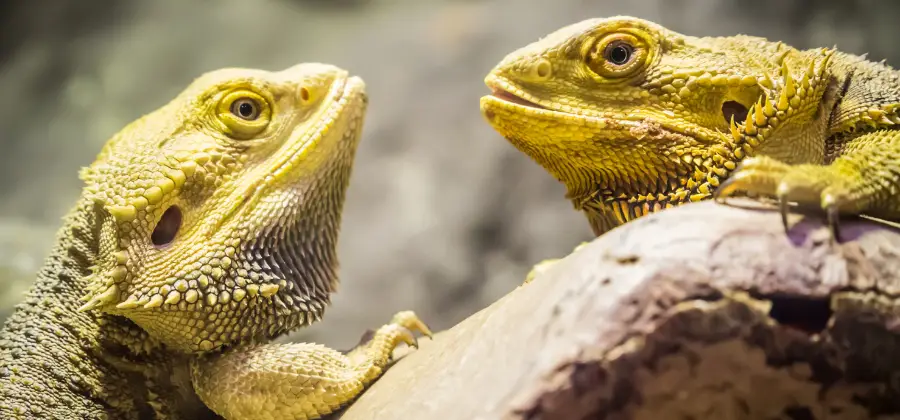
Remember, consistent heat is key to preventing issues like undigested food and maintaining proper food intake. By considering these factors and providing an appropriate artificial heat source, you can ensure your bearded dragon’s health and happiness.
How Long Can a Bearded Dragon Go Without Heat?
Bearded dragons are popular reptiles kept as pets worldwide for their unique appearance and relatively easy care. These creatures originate from the arid regions of Australia and require a specific temperature range to thrive.
In captivity, it’s crucial to provide them with the right heat sources to replicate their natural habitat, as this ensures their proper growth, digestion, and overall health.
Being ectothermic animals, bearded dragons rely on external heat sources to regulate their body temperatures. Under normal circumstances, it’s essential to maintain a basking area with a temperature of around 95°F to 110°F and a cooler area of 75°F to 85°F in their enclosure.
However, situations might arise where a bearded dragon’s heat source is temporarily unavailable. Understanding how long these reptiles can go without heat is crucial for pet owners to take the necessary precautions and maintain the well-being of their pets.
Importance of Heat for Bearded Dragons
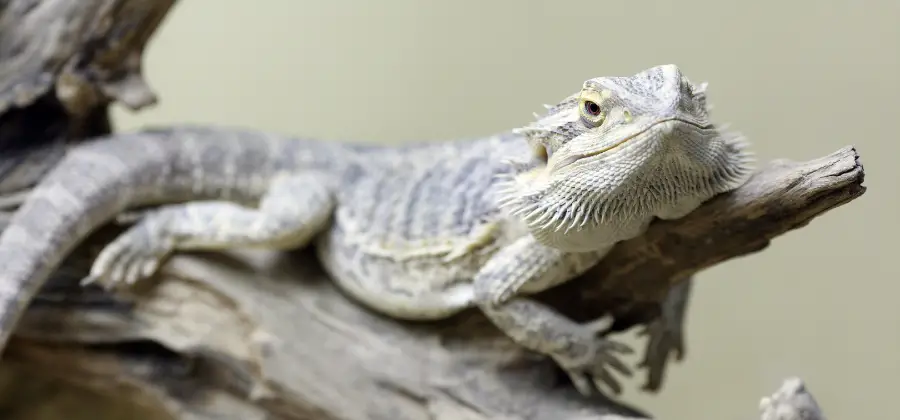
Cold-Blooded Reptiles
Bearded dragons are cold-blooded reptiles, meaning they rely on external sources of heat to regulate their body temperature. Their behavior, metabolism, digestion, and overall health are all greatly influenced by environmental temperature.
In their natural habitat, bearded dragons bask in the sun for warmth, and they need a similar heat source in captivity to thrive.
Body Temperature and Metabolism
The body temperature of a bearded dragon directly impacts its metabolic rate. Higher body temperatures lead to increased activity levels and faster metabolism. A constant and appropriate heat source helps maintain the optimal body temperature range for bearded dragons, which is between 98°F and 110°F.
It’s important to provide a temperature gradient in their enclosure, allowing them to move between warmer and cooler areas as needed.
To support thermoregulation, bearded dragons are known to change their skin coloration. This color change assists in absorbing or reflecting heat to maintain their body temperature within the optimal range.
Digestion and Nutrition
Proper heat is essential for the bearded dragon’s digestion and nutrition. Cold temperatures can slow down or even halt their digestive processes, leading to discomfort and potential health issues. Bearded dragons need to maintain an optimal body temperature to digest food, absorb nutrients, and synthesize vitamins efficiently.
Health Issues Related to Temperature
Inadequate or inconsistent heat can negatively affect the health of a bearded dragon. Exposure to cold temperatures for extended periods can suppress their immune system, increasing their risk of developing respiratory infections and other illnesses. Additionally, poor temperature regulation can lead to lethargy, loss of appetite, and difficulty shedding.
To ensure the well-being and longevity of your bearded dragon, it is crucial to provide the appropriate heat source and temperature gradients within their enclosure. This will support their metabolism, digestion, nutrition, and overall health.
Optimal Temperature Range for Bearded Dragons
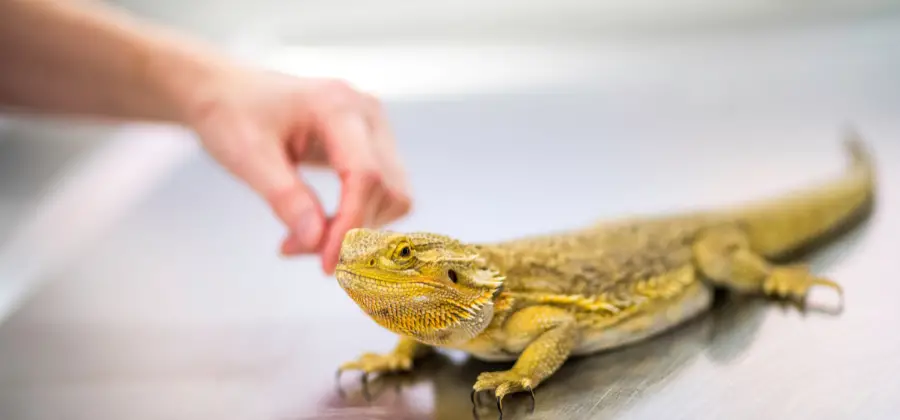
Ideal Basking and Overall Temperatures
Bearded dragons are cold-blooded reptiles that rely on external sources of heat to maintain their body temperature. Providing the appropriate temperature range in their habitat is essential for their well-being and proper digestion. A proper environment includes both basking and overall temperatures.
The ideal basking temperature for a bearded dragon is between 95°F to 110°F (35°C to 43°C), allowing them to thermoregulate properly. Measure the basking spot’s temperature using a thermometer to ensure accuracy.
The overall temperature of the enclosure should be kept within a range of 75°F to 85°F (24°C to 29°C) during the daytime to prevent overheating. This area should be opposite the basking spot to create the necessary temperature gradient.
Temperature Gradient
A temperature gradient is essential in a bearded dragon’s enclosure, allowing them to regulate their body temperature by moving between the cooler and warmer areas. The gradient should range from the basking spot to the cooler side of the enclosure.
Key elements of the temperature gradient:
- Basking spot: 95°F to 110°F (35°C to 43°C)
- Warm side: 85°F to 90°F (29°C to 32°C)
- Cool side: 75°F to 80°F (24°C to 27°C)
Use multiple thermometers inside the enclosure to monitor and maintain the gradient effectively.
Night Temperature
During the night, bearded dragons should experience a slight drop in temperature to mimic their natural environment. It’s recommended to provide a night temperature range of 65°F to 75°F (18°C to 24°C) for optimal health.
Make sure to monitor the temperature with a thermometer and avoid using a heat lamp during the night, as it can disrupt their sleeping patterns. An under-tank heater or a ceramic heat emitter can be utilized if supplemental heating is necessary.
In summary, maintaining the proper temperature range and gradient is crucial for a bearded dragon’s health and comfort. Regularly monitor and adjust the enclosure’s temperature using thermometers to ensure a suitable environment.
You may like to read: 15 Small Low Maintenance Pets
Coping with Cold: Brumation and Short-Term Survival
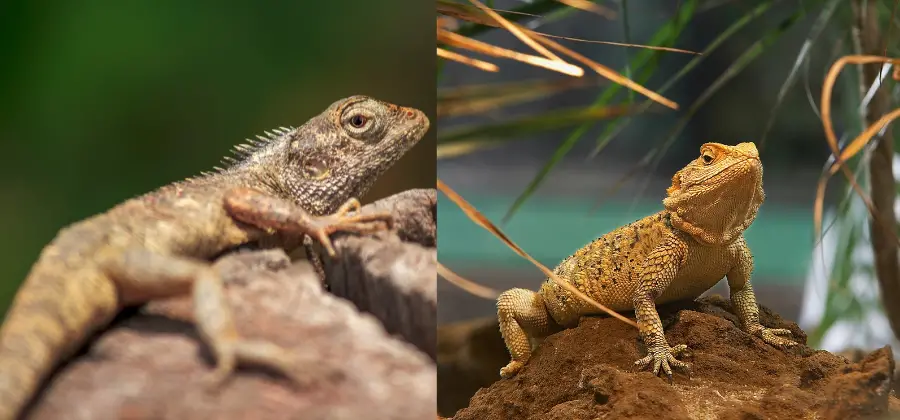
Brumation in Bearded Dragons
Bearded dragons (Pogona vitticeps) are ectothermic reptiles which means they rely on their environment for thermoregulation. Their native habitat in the Australian deserts have seasonal temperature fluctuations, and therefore bearded dragons have developed unique adaptations to cope with these changes. One such adaptation is brumation – a hibernation-like state of dormancy that occurs during the cold season.
During brumation, bearded dragons significantly decrease their metabolic rate, which in turn reduces their energy expenditure and need for heat. They tend to sleep more, eat less, and generally become less active in response to lower temperatures. This state can last for several weeks to months, depending on the duration of the cold period.
Some important factors to consider during brumation:
- Temperature range: Ideally, the temperature in the enclosure should be maintained between 60-70°F (15-21°C) during brumation.
- Light cycle: Although the bearded dragon may not be as active during brumation, it is essential to maintain a proper light cycle that mimics their natural habitat.
- Monitoring health: Regularly monitor the bearded dragon’s weight and health throughout the brumation period to ensure they are not experiencing any significant weight loss or health issues.
Surviving Brief Periods without Heat
Although bearded dragons are adapted to cope with cold temperatures during brumation, they might still face some challenges if they are exposed to a sudden drop in temperature or lack of heat for short periods.
When exposed to cold temperatures for a limited time, bearded dragons can survive for about 24 to 48 hours without heat.
However, it’s essential to act quickly once you notice the absence of heat or cold temperatures. Prolonged exposure to cold can lead to various health issues, including:
- Decreased immune system efficiency, making the bearded dragon more susceptible to diseases.
- Impaired digestion, as reptiles rely on external heat to digest their food effectively.
- Sluggishness and lethargy, which may affect their overall activity levels and well-being.
To ensure your bearded dragon’s survival during brief periods without heat, it is crucial to take the following actions:
- Monitor enclosure temperatures on a regular basis to detect any malfunctioning of heating elements or sudden drops in temperature.
- Provide adequate insulation to minimize heat loss, such as using blankets or towels to cover the enclosure.
- Utilize alternative heat sources, such as portable heaters or heating packs, until the primary heat source is restored.
Remember, it’s vital to avoid exposing your bearded dragon to cold temperatures for an extended period. Always strive to maintain proper heat and light conditions in their enclosure to ensure their health and well-being.
How Long Can a Bearded Dragon Go Without Heat? Watch this
Emergency Heating Solutions
Alternative Heating Sources
When your bearded dragon’s primary heat source fails, it’s crucial to have alternative solutions to keep them warm and healthy. Alternative heating sources can be temporary solutions if a primary heat source is unavailable:
- Ceramic Heat Emitters: These devices emit heat without producing light, making them suitable for maintaining the temperature during nighttime or power outages. Ensure they are compatible with your dragon’s enclosure and always use a thermostat to regulate the temperature.
- Heat Mats: Placing a heat mat under one side of the enclosure can help to provide additional warmth. Be cautious of the temperature and avoid overheating, as it can be harmful to your bearded dragon.
- Heat Packs: These can provide temporary heat for your bearded dragon during emergency situations or traveling. Make sure to wrap them in a cloth or towel to avoid direct contact with your reptile’s skin.
Planning for Power Outages
Power outages are unpredictable and can leave your bearded dragon without a heat source. In such scenarios, consider the following steps:
- Monitor the temperature: Quickly assess the temperature inside the enclosure and make adjustments as needed. Purchase a battery-operated thermometer to have on hand during power outages.
- Use alternative heat sources: Implement temporary heating solutions like ceramic heat emitters, heat mats, or heat packs.
- Provide insulation: Keep your bearded dragon’s enclosure well-insulated by covering it with blankets or towels. Ensure some ventilation to prevent suffocation.
Travel
Traveling with a bearded dragon can be challenging, as maintaining proper heat is essential for their well-being. Follow these tips to ensure a comfortable journey:
- Plan ahead: Pack alternative heating sources like heat packs, a portable heat mat, or a battery-operated heat lamp. Also, bring a thermometer to monitor enclosure temperatures.
- Direct sunlight: When traveling during daytime, placing the enclosure near a window can provide natural warmth from the sun. Be cautious of prolonged direct sunlight, as it can overheat the enclosure or cause sunburn to your bearded dragon.
- Temperature regulation: Keep the car’s internal temperature comfortable for your bearded dragon, depending on the species’ specific needs. Avoid parking in direct sunlight to prevent overheating, and crack open a window for airflow if necessary.
By preparing for emergencies and implementing alternative heating sources, you can ensure your bearded dragon remains healthy and comfortable during power outages and travel situations.
Read next: 15 Best Pet Lizards For Beginners
Preventing Health Problems Due to Low Temperatures
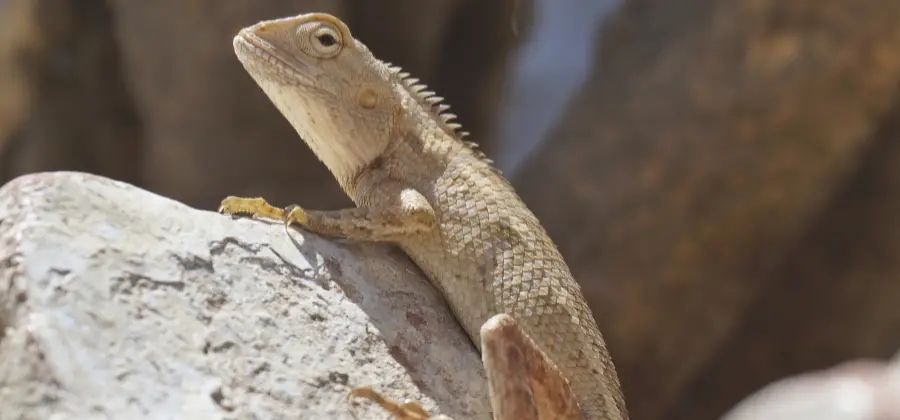
Proper Enclosure and Temperature Monitoring
A bearded dragon’s enclosure plays a crucial role in maintaining its health, especially when it comes to temperature. The ideal temperature range for a bearded dragon is between 75°F (24°C) and 95°F (35°C) during the day, with a basking area of around 100°F (38°C) to 110°F (43°C).
To achieve this temperature range, set up a heat lamp on one side of the enclosure, allowing a gradient for your bearded dragon to thermoregulate. Use a digital thermometer to monitor the temperature in different areas of the vivarium. Adjust the heat source as needed to maintain the desired temperature range.
Maintaining Humidity Levels
Proper humidity levels are also essential for preventing health problems due to low temperatures. Bearded dragons typically thrive in humidity levels between 30% and 40%. To monitor the humidity levels in your dragon’s enclosure, use a hygrometer.
To maintain optimal humidity levels, provide a shallow water dish in the enclosure and mist the enclosure lightly every couple of days. If the humidity is too low, you can add a larger water dish or a reptile fogger. If the humidity is too high, increase ventilation or reduce the frequency of misting.
Addressing Health Issues Caused by Cold
Cold temperatures can cause various health problems in bearded dragons, such as sluggishness, decreased appetite, and respiratory infections. If you notice any of these issues or suspect that your dragon’s environment is too cold, take the following steps:
- Double-check the temperature in different areas of the enclosure using a digital thermometer.
- Adjust the heat source or heat lamp to ensure that the vivarium maintains the proper temperature range.
- Monitor humidity levels to prevent respiratory issues and ensure a healthy living environment.
In summary, proper enclosure setup, temperature monitoring, and humidity control are all critical aspects to ensure your bearded dragon remains healthy, even when facing cold temperatures.
Conclusion

Whether it’s winter months or the need for additional heat, this complete guide will help you provide the optimal environment for your scaly companion. Don’t miss out on essential tips for maintaining the right temperature, ensuring proper calcium absorption, and promoting an active lifestyle.
As a responsible bearded dragon owner, understanding the importance of body heat is paramount. These cold-blooded animals rely on ambient temperature to regulate their internal warmth. Cooler temperatures can lead to health complications, such as loss of appetite.
To keep your dragon warm, providing external sources like heating pads and hot water bottles is crucial. Regularly monitoring temperature requirements using contactless thermometers or dial thermometers ensures their well-being, even if you need to step away for a couple of hours.
A bearded dragon’s ability to go without heat depends on several factors, such as its age, health, and the surrounding environment. While exact durations may vary, bearded dragons generally should not be without proper heating for extended periods.
Healthy adult bearded dragons can potentially survive without heat for up to 24 hours, although it’s not recommended. However, younger and less healthy bearded dragons will likely struggle without proper heating for more than just a few hours.
It is essential to provide a proper heating source, like a UV light, to ensure your bearded dragon maintains adequate body temperature and functions at their best. Prolonged exposure to cold temperatures can lead to health issues, such as respiratory infections or lethargy.
In cases of power outages or temporary unavailability of heat sources, keep a close eye on your bearded dragon’s behavior and appearance. If you notice any signs of distress or lethargy, take immediate action to reintroduce warmth to their environment.
To sum up, it’s crucial to avoid situations where your bearded dragon is without heat for extended periods. Ensuring proper heating and lighting is one of the essential elements for a healthy bearded dragon.

